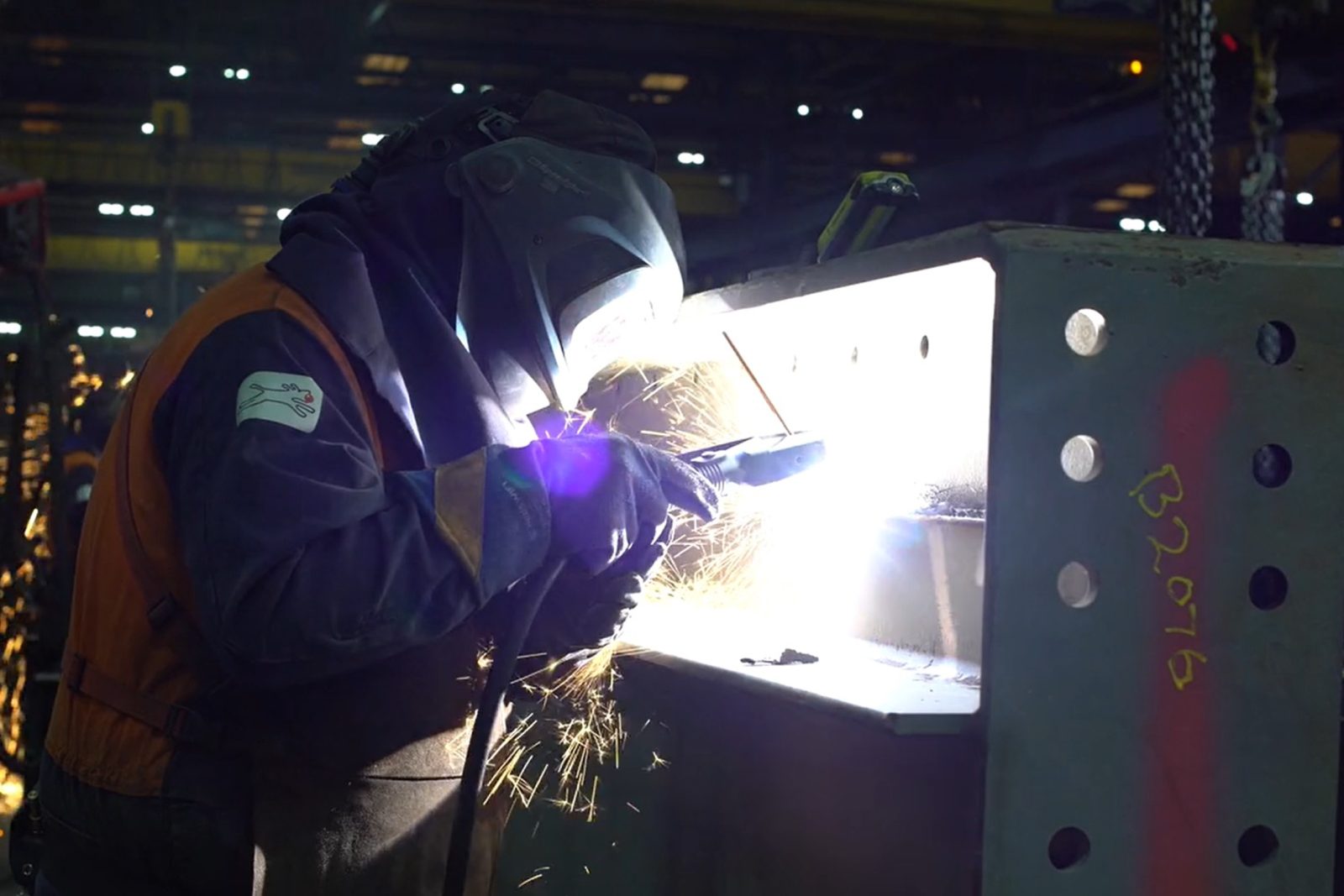Steel is responsible for between 7 and 9 per cent of the world’s carbon emissions. Reusing steel saves up to 96 per cent of the carbon emissions of using new steel. But most scrap steel in the UK is not directly reused, being instead largely sent overseas for recycling.
How can the construction industry, the sector that consumes the most steel, reuse more? And what are the implications for the industry?
Ian Holdsworth, vice-president for the UK & MENA at stainless steel producer Outokumpu, Rachel Hoolahan, an associate at architecture practice Orms, Asselia Katenbayeva, a research associate with the Alliance for Sustainable Building Products (ASBP), Paul Ruding, strategic specification director of steel products manufacturer ACS Stainless, and Charlie Wedgwood, head of carbon at specialist engineering contractor McGee, recently sat down to discuss the sustainable use of steel in the construction industry with Will Hurst, managing editor of The Architects’ Journal.
In terms of carbon emissions, ‘reuse always trumps recycling,’ Hoolahan affirmed. Reusing steel cuts carbon emissions by as much as 96 per cent compared with using virgin metal.
But some 95 per cent of scrap steel in the UK is recycled, rather than directly reused. Recycling produces on average about 80 per cent less carbon than new steel, Katenbayeva said.
‘Another issue,’ Katenbayeva added, ‘is that 77 per cent of scrap generated in the UK is exported and it’s recycled or melted somewhere else. And then these products are imported back to the UK.’ This is because the UK doesn’t have enough recycling capacity, she explained.
Holdsworth, whose Finnish company sold its Sheffield electric arc furnace in January, said that melting down scrap for reuse in the UK was much more expensive than in its other locations in Finland and Sweden because of the high electricity prices here. ‘It’s sufficient for us to prefer not to melt here,’ he added.
Katenbayeva said the UK’s low recycling capacity represented a ‘missed opportunity’, but suggested that the domestic construction industry should focus more on reusing steel for environmental and socioeconomic reasons.
So how do you reuse steel? Firstly, you have to assess what you have, said Wedgwood, whose firm works in demolition and deconstruction. Steel produced after 1970 is reusable, according to current regulations, although research is being done that may lead to that limit being pushed back to 1935.
Next, it’s important to assess the steel not just for its embodied carbon but also for its actual reuse value, Wedgwood continued.
Katenbayeva added: ‘It’s very important to have the past history of this material […] And this is because if that piece of steel was subject to dynamic loads – for example, if it was used in bridges – it cannot be reused. If that piece of steel had been in a fire, it cannot be reused.
‘It’s very important to know the material grade properties, any tests conducted, the certification available. This is because if we have that material traceability, then the testing and recertification processes are easier. They also become more affordable – and that affects the economics of steel reuse.’
Taking the example of Hawkins\Brown’s 1 Golden Lane office redevelopment in the City of London, Wedgwood told the audience how the developers took the steelwork from the building to reshape and reuse it in the framework of the vertical and lateral extensions of the same Grade II-listed structure.
Other work that steel has to undergo before it can be reused includes ‘defabrication’ – removing any existing connections and attachments – as well as various strength and condition tests, Wedgwood said. The steel then has to be recertified before it can be reintegrated into a building.
Reused steel is rarely built back into the same building. There are two principal ways of procuring reused steel – either from a stockholder or buying directly from a developer who is demolishing another building with a steel frame.
From an architect’s perspective, it’s important to discuss reused steel with the client early on, Hoolahan said. ‘Once a client is getting on board with the idea, the next step is to manage the expectations regarding aesthetics, programme and cost,’ she added. Citing a building that Orms recently retrofitted in London’s Sloane Square, Hoolahan said that a key means of keeping costs down was to ask the structural engineer not to design bespoke sections for steel beams, such as stepping the beam down at the perimeter of a terrace. Environmental benefits aside, reused steel may actually end up being cheaper than new steel. An ASBP study of 11 schemes that reused steel found that five were ‘cost-neutral’ or ‘cost-positive’. In other words, the reused steel brought an economic advantage to the project.
But while it bumps up its own sustainable credentials, a developer reusing or recycling steel for its own buildings may not be the best thing for the environment as a whole unless the approach is properly thought-out.
‘Because we don’t have enough scrap metal in the world to supply all of the steel that we’re going to need, if we hang onto the steel that’s in one of our buildings, for example, we’re preventing it from entering [the supply chain] and being recycled content elsewhere,’ Hoolahan said.
‘So, we could start to hold onto our steel and potentially over-engineer the steel design and make that [business] carbon-saving. But then what it’s going to mean is we need to extract more virgin iron ore to make that new steel where the demand still exists.
‘When you start a project, you almost need to ask the client: “are you doing this for overall global benefit or are you doing this for your overall project benefit?”’
And recycling works better for some kinds of steel than for others. Stainless steel, which is largely used for components, is better recycled than reused, Ruding said.
‘Stainless is a little bit harder [to reuse], which is why it tends to go towards recycling. And because you can recycle 100 per cent of it, it really does make it a brilliant material.’ By contrast, ‘basic’ carbon steel, which is more often used structurally, is easier to reuse.
Although both reusing and recycling steel clearly bring emissions advantages over using new material, Ruding and Holdsworth sounded a note of caution about the accuracy of emissions data.
Holdsworth called for more a more uniform standard for emissions reporting in the steel industry, calling the current set-up ‘confusing’.
Most steel producers, he said, report carbon emissions from their own production and the emissions from electricity generation – but not from their supply chain and raw materials. ‘There’s very little consistency when it comes to the reporting,’ he said.
Ruding agreed, stressing the importance of manufacturers accurately representing their emissions figures so that any disparities don’t become amplified further down the supply chain.
‘If that information isn’t completely correct and goes into the nth degree, architects aren’t going to know exactly what’s going into their building.
‘So the importance of that is only going to get more and more as we go forwards and it’s something that needs addressing.’
Sponsored by
 The Architects’ Journal Architecture News & Buildings
The Architects’ Journal Architecture News & Buildings
